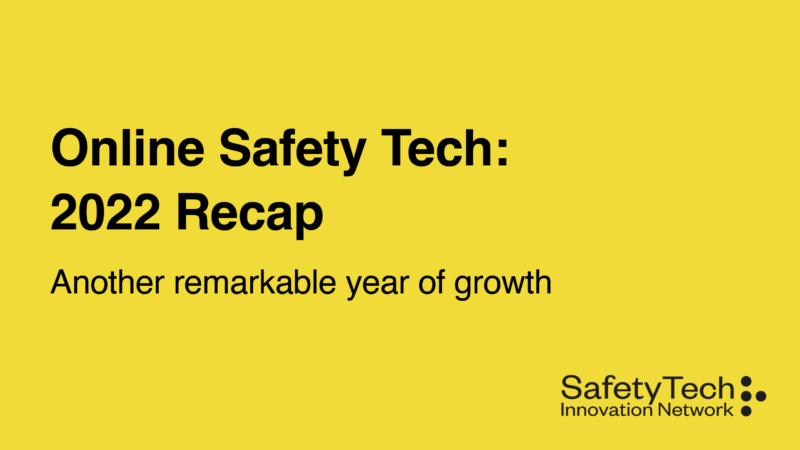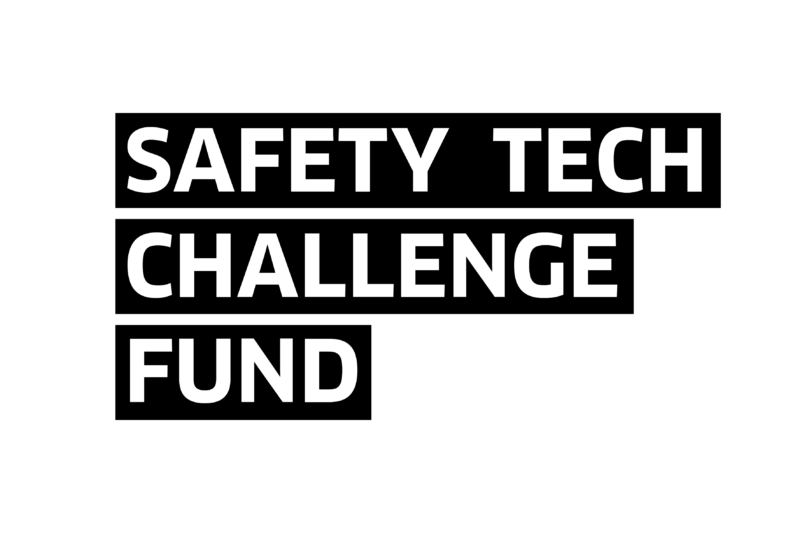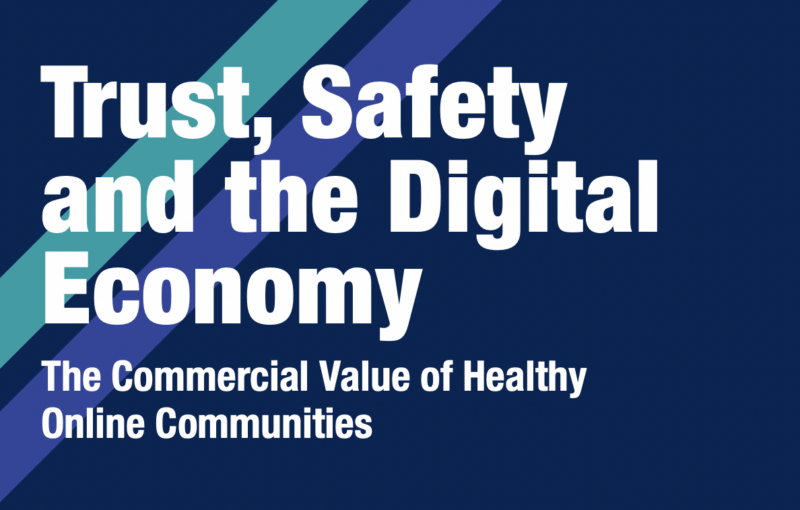Safety Tech trends 2022: North Star values
Graham Francis and Sofia Hicks from the DCMS Safety Tech team reflect on the core values of Safety Tech, and areas to watch out for during 2022.
We’re beginning 2022 with so much excitement about the potential of Safety Tech – the use of technology to create and maintain safer and more secure online environments for users.
Safety technologies aim to support businesses all over the world with the right tools to establish and maintain platforms on which people can lead their best lives, without fear of being targeted for hate or harassment simply because of who they are or how they feel about issues: technologies that empower users to create the type of experience that is right for them, and the types of cyber society in which they want to participate.
In this blog post, we take a step back to suggest five key themes that might be worth looking out for, as well as our thoughts on some of the ‘north star’ principles which might help guide sector development in the coming year.
1. Principles, patterns and people
The first thing to say is that most conversations we have about Safety Tech aren’t really about the tech. They’re about the systems, processes and cultures that support companies to create safer online environments for users, and the role of tech within this – ultimately they are about people, about you and I – the users. In short, they’re about tech as a tool, a means to an end, rather than an end in itself.
And through the year, as we’ve organised seminars, events and working groups through the Safety Tech Innovation Network to explore the idea of Safety Tech, a couple of centres of gravity seem to be emerging that help to move forward with this idea.
The first focuses on the idea of ‘Safety by Design’ – the need for a set of consistent user-focused, evidence-driven guide rails that help companies build considerations of user safety and well-being into digital products from the beginning, without compromising the overall user experience, or the commercial viability of an innovation. These ideas help to set the context for the positive use of tech – although tech can be uniquely helpful at helping to flag up harmful content, conduct or contact at scale, it needs to be considered by organisations within a much wider framework of the measures that they could take to better protect users.
The concept of Safety by Design is now starting to enter the mainstream of tech discussions, and we were particularly excited to see the publication of Eva PenzeyMoog’s ‘Design for Safety’ book for web designers and developers last August. This book nicely compliments more official guidance from the UK government, Australia eSafety Office and the Fair Play Alliance Framework for the gaming industry and guidance from WeProtect on protecting children. We’ve also been working closely with the Information Commissioner’s Office in the UK, whose world-first age-appropriate design code is helping to raise the bar in standards of data protection for children.
Looking into 2022, it will be interesting to track the adoption and use of these tools, and see how they evolve to help industry understand and tackle more granular and concerning harm types, such as harassment, grooming or suicide ideation. When considering the needs of designers and product teams, it is apparent that there are precedents here from other sectors, for example the A11y design patterns for accessibility and the data privacy design patterns from ‘Projects By If,’ both of which are co-created by industry. We’re particularly keen to see how organisations use the Design Patterns for Mental Health, which was launched this year by Barnardo’s, Public Policy Lab and Snook – and whether this might provide a template for the further development of Safety Tech.
The second, related, centre of gravity focuses on the idea of design principles for Safety Tech – whether we can capture a set of ‘north star’ values that can help guide the industry towards developing and maintaining a set of products which are ethical, robust, trusted and safe by design (a few examples are collected here). Our research into Safety Tech Skills and Capabilities over the summer of 2021, demonstrated that there was a strong alignment around a set of core set of values spanning issues such as user privacy, diversity and data ethics. A working group within the Safety Tech Innovation Network, led by Dr Jacqui Taylor, have been developing these ideas and we’re looking forward to sharing their initial thoughts in the next few months, alongside a separate workstream that looks specifically at how we can support greater diversity within the sector.
2. Trust, safety and the digital economy
The past year has seen several defining moments for the Safety Tech sector – but perhaps among the most significant was the announcement by Chelsea and Liverpool FC, which said they would be working with a Safety Tech company to detect and address toxicity against their players. Implicit in this is an acknowledgement of the damage that online toxicity can do not just to individuals, but also to online brands and communities – and, conversely, of the value to business on solutions that protect user safety.
This builds on some of the themes established by the Safety Tech Expo 2021 that we organised back in March, in which brands including EA, Lego, Match, and Meet spoke about the work they were doing to create safer online communities. Echoing this theme, in May 2021 the Safety Tech company Crisp published the results of a study by Forrester which suggested its clients received a 572% return on investment from the use of its products and services; and the Brand Safety Exchange has recently featured an interview with Agora on the same theme.
We’ll be digging deeper into this theme further during Spring 2022, when we publish an Ipsos MORI report that features the contributions of dozens of industry experts, and takes a systematic view of the value of online trust across core sectors of the UK economy. And following on from this, we’ll be drilling deeper into the opportunity for a greater emphasis on trust and safety to help to underpin a resilient, sustainable digital economy.
We’d also like to look further into showcasing the employment potential of the Safety Tech sector – our skills and capability research, carried out last May, revealed that job retention rates for skilled staff within the Safety Tech sector were considerably higher than they were for other parts of the tech sector, suggesting that once skilled staff find the sector, its compelling mission makes them want to stay there.
3. A growing global sector
Over the past year, it has been tremendously exciting to see the opportunities presented by Safety Tech climb higher on the global agenda, and a coming together of organisations from across the globe to collaborate on best practices in trust and safety – and this is certainly something that looks set to continue during 2022.
On the international sphere, a hugely significant step was made in April 2021, when a joint Ministerial Declaration from G7 countries included a specific commitment to ‘share information, research and best practice for the development and adoption of safety technology’, and in November 2021, we were delighted to host the first G7 Safety Tech Summit which included a keynote address from Australian eSafety Commissioner Julie Inman Grant. Further evidence of the mainstreaming of trust and safety into international fora was provided at the inaugural Future Tech Forum in November 2021 at which delegates from across the globe discussed the potential of technologies such as Safety Tech to help tackle global challenges. We’re very much looking forward to building on these multinational connections over the next year.
The past year has also seen the growth potential of Safety Tech discussed in greater depth from national perspectives. In May 2021, the DCMS Safety Tech Sector Analysis revealed a sector revenue growth rate of 39% and employment growth rate of 29%, making it one of the UK’s fastest-growing tech industries. Elsewhere, the German Safety Tech sector gained momentum, and Paladin Capital have recently described the emergence of a £1bn US Safety Tech market in its recent, groundbreaking report. A Dealroom Safety Tech Dashboard featuring more than 175 global sector companies was released in the summer, while considerable investor appetite for Safety Tech was demonstrated by ActiveFence’s $100m funding round and Two Hat’s acquisition by Microsoft.
We’ve been hugely excited by what feels like a real groundswell of collaborative, multistakeholder, international projects over the post year focusing on trust and safety. The Online Safety Tech Industry Association continued its rapid expansion to bring together Safety Tech companies across the globe, while the Trust and Safety Professional Association, Oasis Consortium, Fair Play Alliance and Global Coalition for Digital Safety also went from strength to strength, providing unparalleled sources of practical insight and expertise. We’ve also been excited to work closely with global organisations focusing on tackling specific harms, including the WeProtect Global Alliance and Tech Against Terrorism.
Meanwhile, through the Safety Tech Innovation Network, we’ve been building up a network of more than 700 individuals and organisations who are interested in the Safety Tech mission. (If you’ve not yet subscribed to our monthly online newsletter, do it now!)
4. Safety Tech and user privacy
Apple’s move to include automated scanning for known illegal child sexual abuse images in its new operating system hit the headlines over the summer, triggering a global debate on the relationship between online safety and user privacy, including the use of end-to-end encryption.
We’re hoping that this debate will be further informed by the outcomes of the Safety Tech Challenge Fund, which seeks to support innovative ways in which illegal child abuse content can be detected while respecting user privacy. We launched this fund in autumn 2021, and over the next few months we’ll be bringing you news and updates from selected projects, including the results of independent evaluation of the projects.
More broadly, we’re conscious of the need for continuous, constructive dialogue across the spectrum on how to ensure the additional protections that the use of tech to detect harmful content can give users, with the need to protect human rights, liberty and dignity in cyberspace. The model is not binary, and we’re interested in exploring more how the use of tech relates to a broader spectrum of rights, the framework for much of which society has been developing over hundreds of years. For example, the Internet Rights and Principles Commission’s ‘Charter of human rights and principles for the internet’ draws on the Universal Declaration of Human Rights to develop a model for how we might be able to apply concepts of liberty to the online environment, and position the use of tech within this. These aren’t simple questions – far from it – but it’s incredibly helpful that industry experts such as Neil Brown and Jen Persson are helping to inform and drive the debate on how we can all ensure that all use of tech considers the right safeguards.
5. Data infrastructure and technical standards
We’ve been fortunate enough to speak to hundreds of people about Safety Tech over the past couple of years, in public consultations, roundtables and other forums. One of the issues that’s been raised most often involves standards – and, specifically, the role that a mature standards framework could play in promoting the growth of technologies that are trusted by citizens and businesses alike.
Data standards sit at the heart of this landscape, which is why over the past year or so, the Online Safety Data Initiative has focused on the opportunity for measures such as trusted research environments, consistent taxonomies and common evaluation frameworks can help ensure that machine learning systems are underpinned by consistent high-quality data, and systems for data protection. We’re looking forward to bringing you some of our key learnings from this work over the next few months.
More broadly, it has also been interesting to see principles and guidance for use of technology form part of the online safety standards frameworks proposed by the industry-led Trust and Safety Partnership and Oasis Consortium.
As safety technologies evolve, we have also begun to see discussions within industry of what a technical infrastructure might look like that leans more towards ideas of interoperability and consistent technical standards across sites. For example, the Content Authenticity Initiative, which seeks to address misinformation through standards for digital content provenance. There has also been increasing buzz around the potential to apply models such as ‘middleware’ to the online environment, led in part by Francis Fukuyama’s team in Stanford – this helpful blog post collects together much of the recent thinking on this, as well as an interview with Prof Fukuyama. And in a fascinating column for Wired last April, Tracy Chou, CEO of Block Party, highlighted the role that open APIs could play in supporting the growth of a market of third-party consumer tools such as that help individuals reach a more granular level of control over the types of content they see, or messages they receive across apps.
Join us for the journey
One of the fascinating things about working on Safety Tech is the range of issues it encompasses – it’s an ever-changing landscape, but one which has huge implications for the future. And as the massive potential of VR unfolds further, these changes are likely only to accelerate.
Through the Safety Tech Innovation Network, we’ll aim to bring you through the year a high-quality mix of news, events and analysis that will help you keep up to speed with the sector as it develops, as well as on the progress towards regulation in the UK.
To keep in touch, don’t forget to sign up to our newsletter if you haven’t done so already. Or drop us a line at safetytech@dcms.gov.uk if you’d like to say hello.



